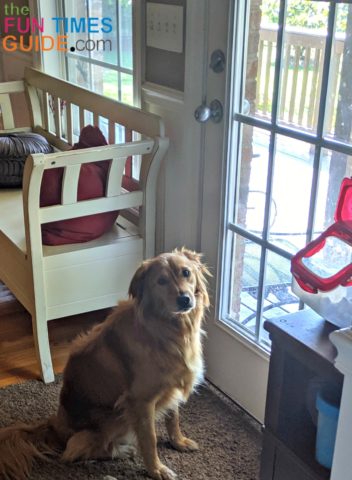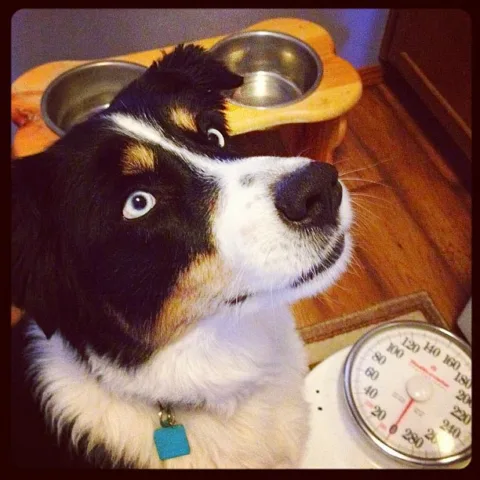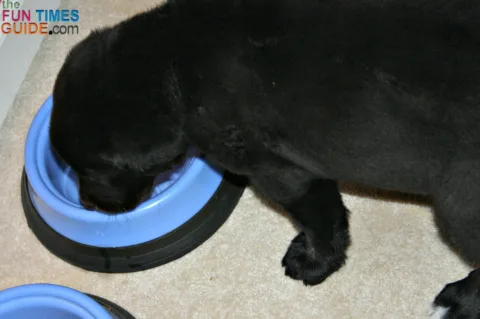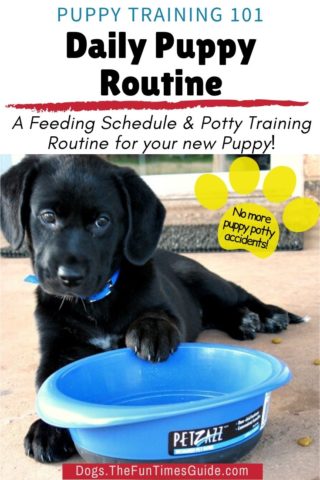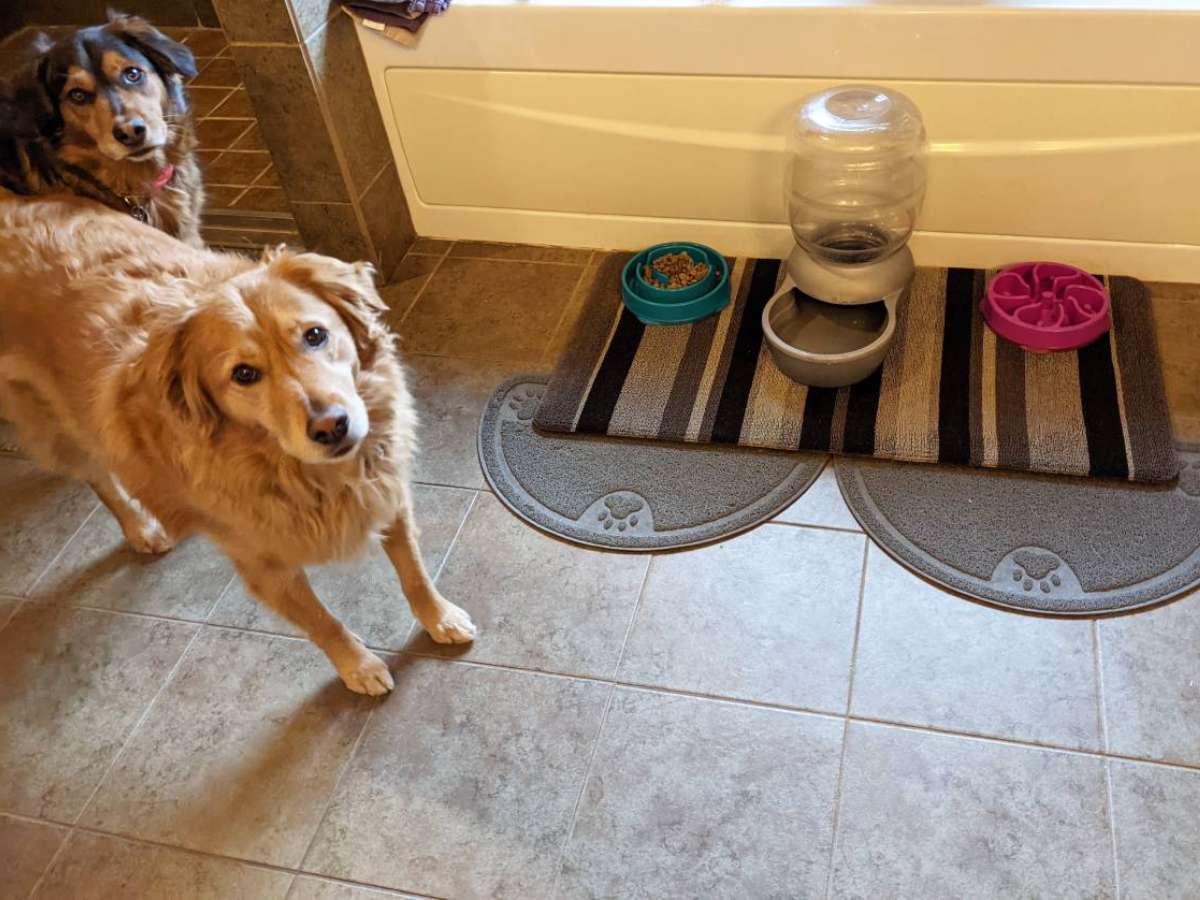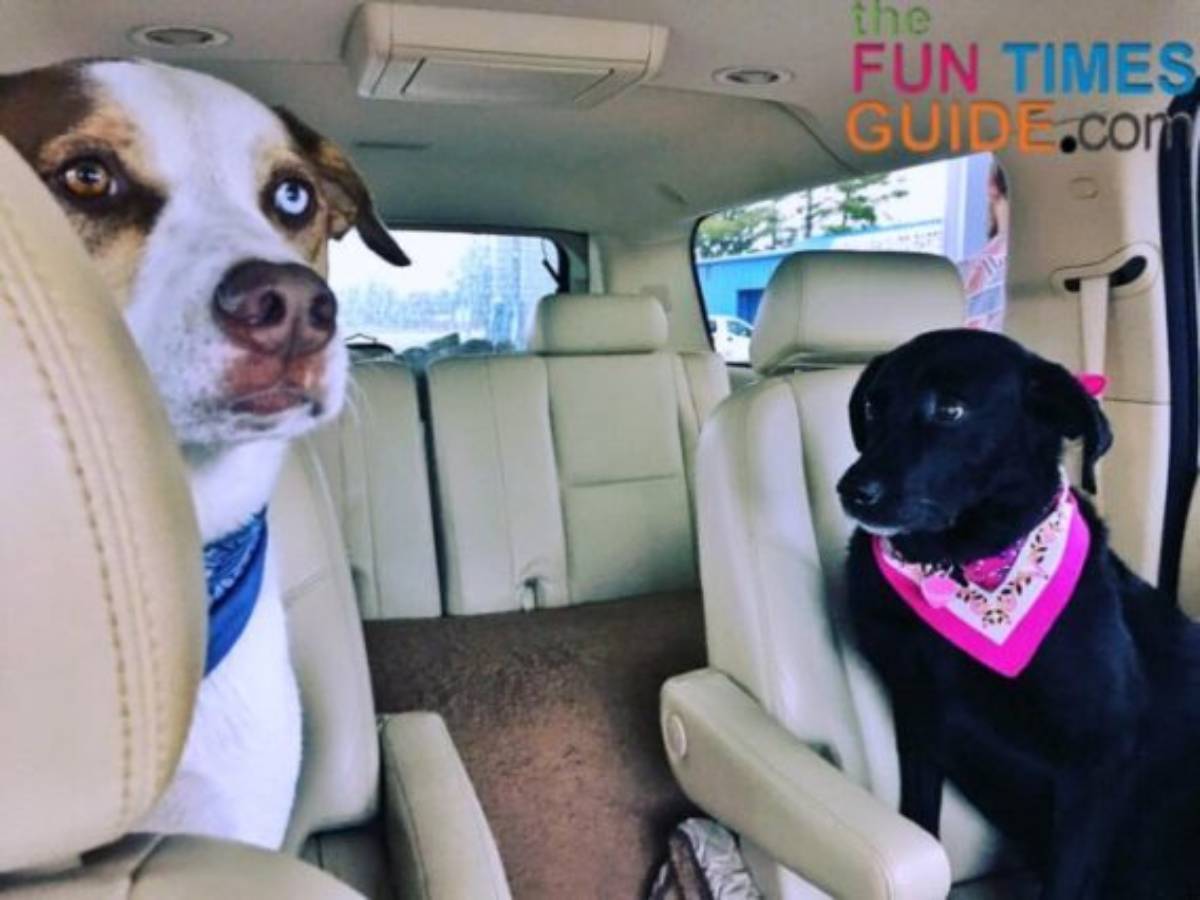When I got my first dog, I was in the same position that lots of first time pet parents find themselves in. I was asking my vet a lot of questions about feeding puppies:
- How often should I feed my puppy?
- How much food does he need?
- What about when he grows up… how frequently do adult dogs need to be fed?
My vet reassured me that a puppy feeding schedule isn’t exactly rocket science. The main thing to remember, she told me, is that consistency comes with lots of benefits.
Now, I’m not a vet – but thanks to my tendency to adopt dogs large and small, I’ve got this whole food scheduling thing down!
Today, I’m going to help you create your own daily dog routine, including:
- Why you should feed a dog on a set schedule.
- How to tell when your dog needs to go to the bathroom.
- What to do if your dog has an accident in the house.
- How to create a puppy feeding schedule.
- When puppies typically have to pee and poop.
- Puppy potty training tips.
- How to create an adult dog feeding schedule.
- Special circumstances for special dogs.
- The best puppy water schedule to start with.
3 Reasons To Feed Your Dog On A Set Schedule
There are several very good reasons to set a dog feeding schedule… and stick with it:
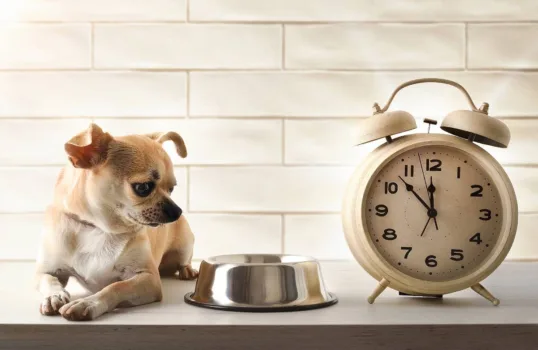
#1 – First, feeding your dog at specific times helps keep their metabolism running smoothly.
#2 – Second, regular feeding times are part of a comforting routine — which is important since dogs are creatures of habit. They thrive in stable environments with consistent sleeping, playing, and feeding times.
#3 – There’s one more important reason to create a feeding routine for your dog, and it’s one that I think you’ll appreciate as much as I do. With a consistent feeding schedule comes a consistent toilet schedule. This makes it easier to housetrain a puppy or an older rescue dog, and it greatly reduces the likelihood of accidents in the house.
Watch for Signs That Your Dog Needs to Go Outside
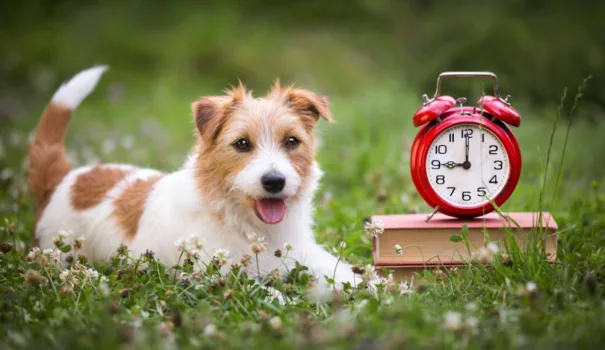
Most dogs need to eliminate within 10 to 15 minutes after finishing a meal.
- Puppies often need to go sooner than that.
- Some dogs will wait a little longer.
Knowing the average timespan between feeding your dog and time to go out can help you create this part of their daily schedule.
While it’s possible to teach your dog to ring a bell or give you another clear signal that it’s time to go out, dogs provide clues that they need a bathroom break.
I’d like to say that the following tips apply to all dogs, but puppies have special rules all their own — which I’ll cover in the puppy feeding schedule below.
How A Dog Signals They Need To Pee Or Poop
These are the most common signs:
- Dogs tend to appear restless when they need to go out.
- If they’re house trained, it’s likely that they’ll go stand next to the door — maybe even pawing at it or whining at you.
- Some dogs will come sit next to you and try to get your attention as a way to signal that they need to go out.
There are a few other signs to watch for — particularly in a younger dog or a newly rescued dog:
- If you see your dog heading for a corner or trotting toward another room, there’s a good chance they’re looking for a place to take a bathroom break.
- If you see your dog sniffing and circling, get them outside quick — because they’re about to do the deed.
It’s sometimes possible to distract older dogs before the floodgates open. But distraction doesn’t work on puppies — because puppies have no control over their bladders and sphincters.
TIP: Particularly with rescue dogs, it’s important that you invest in a dog collar and a name tag (and consider microchipping) — because dogs have a habit of wandering off. If this does happen, use clever resources like Paw Maw to retrace the steps of your lost pet.
I’d like to make one last point here…
What To Do If Your Dog Has An Accident In The House
You should never punish your dog for peeing or pooping in the house!
This is guaranteed to backfire by making your dog too nervous to go to the bathroom in your presence. Instead of peeing or pooping outdoors while you’re waiting at the other end of the leash, they’ll wait until they’re back inside and you aren’t looking.
If you happen to catch your dog going to the bathroom in the house, patiently take them outdoors and see if they’ll finish the job.
Then clean up the accident with an enzymatic cleaner that eliminates the smell and, at the same time, prevents your dog from viewing previous accident sites as acceptable bathroom spots.
Okay, now that we’ve covered the “why” portion of feeding your dog on a schedule, I’m going to share some practical tips for creating your own dog feeding routine…
How To Create A Daily Puppy Routine (Feeding + Potty Training)
For starters, you’re probably wondering how often to feed a puppy.
What Are The Best Times To Feed A Puppy?
Puppies need to eat 3 times a day until they are 12 weeks old.
I’ve had to hire a dog sitter to handle the middle part of the day — and you’ll probably want to do the same thing if your schedule prevents you from caring for your pup in the middle of the day.
After the 12-week milestone, you can switch to feeding Breakfast and Dinner only — but you’ll still want to have a dog sitter on hand to take care of bathroom breaks.
Here are some tips for transitioning your dog from puppy food to adult dog food.
How Often Do Puppies Poop?
Young puppies tend to poop within 10 minutes of finishing a meal. (I’ve had more than one puppy that needed to go out immediately after eating.)
Don’t worry – this isn’t going to last forever.
How Often Do Puppies Pee?
Your puppy will need to urinate frequently, too.
Puppies can hold their bladders for a maximum of:
- 2 hours at 8 weeks old
- 3 hours at 12 weeks old
- 4 hours at 16 weeks old
Drinking more water or being more active reduces the amount of time that your puppy can “hold it”.
The Ideal Daily Puppy Routine
The good news is that most dogs can be completely house trained by 5 to 6 months of age, as long as you stick with a consistent schedule like the one I use:
7 a.m. – Breakfast
7:10 a.m. – Go outside
12:00 – Lunch
12:10 – Go outside
6 p.m. – Dinner
6:10 p.m. – Go outside
7:00 p.m. – Empty your dog’s water bowl to reduce the likelihood of overnight accidents
Puppy Potty Training Tips
- Always take your puppy out immediately after they wake up in the morning.
- Go out hourly — or even more often than that if needed during the day.
- Go out immediately after playing.
- Go out the second they wake up from a nap.
- Go out right before bedtime.
- If your puppy is very young, expect to go out at least a few times during the night.
NOTE: I’m not covering crate training in this article — but I recommend it as part of creating a stable routine for your puppy.
As your pup gets older and develops better control, you’ll get a better feel for how often they need to go out. Eventually, they will only need to take a bathroom break every 2 to 3 hours, depending on their age and activity level.
How To Create A Daily Dog Routine For An Adult Dog
First, you need to know how often to feed a dog.
The average adult dog needs to eat 2 times a day.
At our house, the puppy feeding schedule continues into adulthood — with Breakfast and Dinner being served at about the same time every day of our dogs’ lives.
We feed adult rescues at the same time, too — but we modify the schedule somewhat if they’re used to being fed at times other than our preferred 7 a.m. Breakfast and 6 p.m. Dinner.
Special Circumstances For Special Dogs
We have rescued underweight dogs in the past. For them, we’ve added in a Lunch feeding and more snacks, as well as plenty of extra bathroom breaks.
TIP: If you rescue a severely malnourished dog, be sure to consult with your veterinarian concerning a good feeding schedule — since overfeeding a starved dog can cause more harm than good.
I’ve made accommodations for dogs with medical conditions — not only switching them to customized diets, but also dividing their food into smaller portions and feeding up to 4 times a day, based on my vet’s recommendation.
TIP: If your dog has a chronic condition, be sure to chat with your vet about whether some changes to your normal dog feeding schedule might be helpful.
Active dogs burn more calories. There are a few different ways to ensure that an active dog gets enough to eat. For example, you might consider keeping Lunch time around noon and serving Dinner earlier, along with a second evening meal a few hours later (like within 2 hours of bedtime).
TIP: Sometimes, I’ll give my active dogs extra meals in the form of nutritious treats. They love the “extras” and it gives me the opportunity to reinforce positive behavior in order for them to “earn” these treats – a win-win!
Dogs that live sedentary lifestyles can be fed 2 times a day — but if you notice that they seem to be packing on the pounds, then you might consider swapping to 1 main meal per day and 1 mini meal or light, nutritious snack when it’s convenient (like at their old Dinner time).
TIP: I recommend having a talk with your vet about how best to help your sedentary or overweight dog cut calories without depriving them of their predictable, daily routine.
How To Create A Puppy Water Schedule
Just like us, dogs need to have fresh, clean water to drink.
For puppies, how often they drink water directly affects how often they need to use the bathroom.
If you’re still working on house training your dog, you can make things a bit easier by offering water only during the day and removing the bowl a few hours before bedtime — so there’s a lower risk of overnight accidents.
TIP: Be sure to wash your dog’s water bowl every day, and make sure that they have access to unlimited water during hot weather.
Here’s a sample puppy water schedule:
7 a.m. Fill up the water dish and set it out.
4 p.m. Empty and rinse the dish. Refill it and set it out.
7 p.m. Empty the water dish and wash it with detergent.
Once your dog has been housetrained, it’s perfectly fine to leave water out and available for them 24/7.
If you have a mixed household like we often do, your adult dogs should be okay adjusting to the puppy’s water schedule while you establish a good routine for your new pup. (You can always offer your older dogs an extra drink while the puppy is busy doing something else!)
The Bottom Line
Even though I’ve enjoyed the company of many dogs since I got my first puppy years ago, I still have to watch every new addition carefully after feeding time to determine what their bathroom schedule should look like.
Even though every dog has unique needs based on activity level, age, and perhaps some other considerations… it’s fairly easy to create a feeding routine & potty schedule that meets your pet’s requirements as well as your own schedule.
With healthy food, a reliable bathroom schedule, a lot of playtime, and of course a comfy bed to sleep in, your dog will have the basic building blocks for a healthy life — and you will enjoy many wonderful experiences together.
Like this post? Save it to read again later… or share with others on Pinterest!
Lauretta Williams is a co-founder at PawMaw.com, a website dedicated to reuniting people with their lost pets. In her free time, she enjoys sharing helpful tips for caring for dogs.


